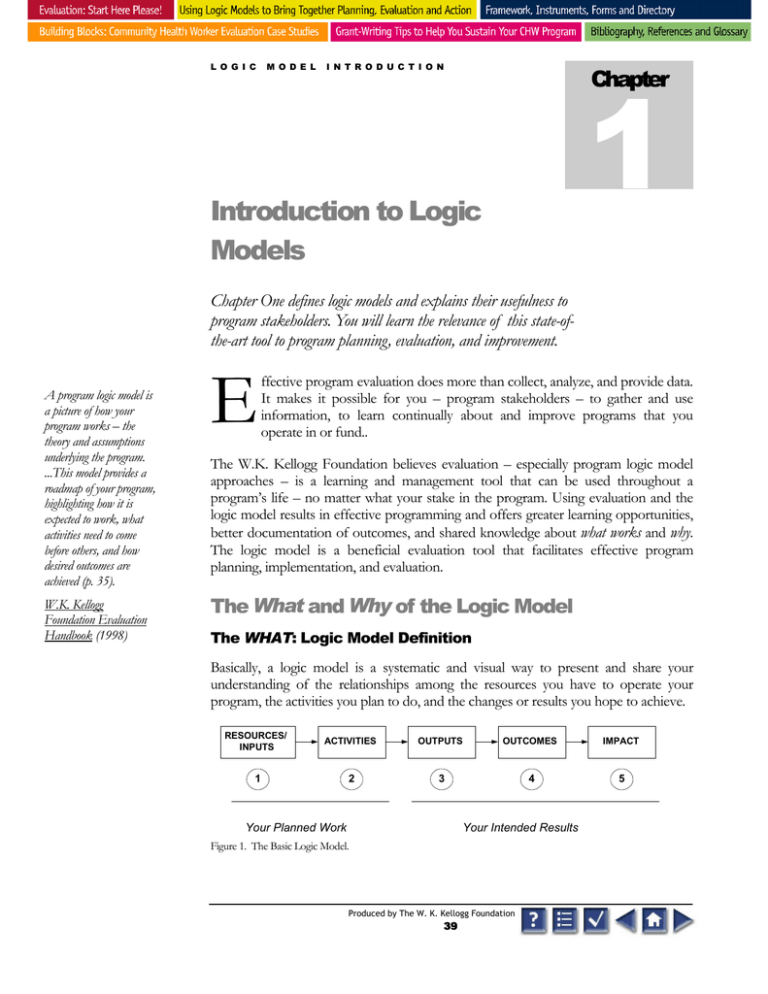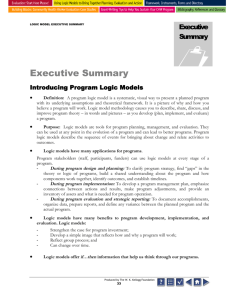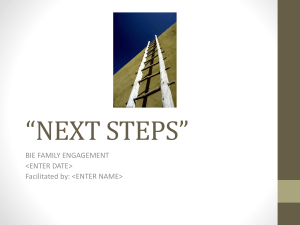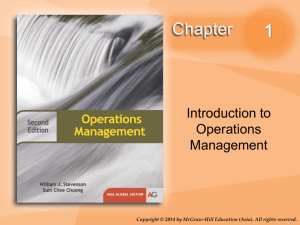Introduction to Logic Models
advertisement

L O G I C M O D E L 1 I N T R O D U C T I O N Chapter Introduction to Logic Models Chapter One defines logic models and explains their usefulness to program stakeholders. You will learn the relevance of this state-ofthe-art tool to program planning, evaluation, and improvement. A program logic model is a picture of how your program works – the theory and assumptions underlying the program. ...This model provides a roadmap of your program, highlighting how it is expected to work, what activities need to come before others, and how desired outcomes are achieved (p. 35). W.K. Kellogg Foundation Evaluation Handbook (1998) E ffective program evaluation does more than collect, analyze, and provide data. It makes it possible for you – program stakeholders – to gather and use information, to learn continually about and improve programs that you operate in or fund.. The W.K. Kellogg Foundation believes evaluation – especially program logic model approaches – is a learning and management tool that can be used throughout a program’s life – no matter what your stake in the program. Using evaluation and the logic model results in effective programming and offers greater learning opportunities, better documentation of outcomes, and shared knowledge about what works and why. The logic model is a beneficial evaluation tool that facilitates effective program planning, implementation, and evaluation. The What and Why of the Logic Model The WHAT: Logic Model Definition Basically, a logic model is a systematic and visual way to present and share your understanding of the relationships among the resources you have to operate your program, the activities you plan to do, and the changes or results you hope to achieve. RESOURCES/ INPUTS ACTIVITIES OUTPUTS OUTCOMES IMPACT 1 2 3 4 5 Your Planned Work Your Intended Results Figure 1. The Basic Logic Model. Produced by The W. K. Kellogg Foundation 39 L O G I C Most of the value in a logic model is in the process of creating, validating, and modifying the model … The Clarity of thinking that occurs from building the model is critical to the overall success of the program (p. 43). W.K. Kellogg Foundation Handbook (1998) M O D E L I N T R O D U C T I O N The most basic logic model is a picture of how you believe your program will work. It uses words and/or pictures to describe the sequence of activities thought to bring about change and how these activities are linked to the results the program is expected to achieve. The Basic Logic Model components shown in Figure 1 above are defined below. These components illustrate the connection between your planned work and your intended results. They are depicted numerically by steps 1 through 5. YOUR PLANNED WORK describes what resources you think you need to implement your program and what you intend to do. 1. Resources include the human, financial, organizational, and community resources a program has available to direct toward doing the work. Sometimes this component is referred to as Inputs. 2. Program Activities are what the program does with the resources. Activities are the processes, tools, events, technology, and actions that are an intentional part of the program implementation. These interventions are used to bring about the intended program changes or results. YOUR INTENDED RESULTS include all of the program’s desired results (outputs, outcomes, and impact). 3. Outputs are the direct products of program activities and may include types, levels and targets of services to be delivered by the program. 4. Outcomes are the specific changes in program participants’ behavior, knowledge, skills, status and level of functioning. Short-term outcomes should be attainable within 1-3 years, while longer-term outcomes should be achievable within a 4-6 year timeframe. The logical progression from short-term to long-term outcomes should be reflected in impact occurring within about 7-10 years. 5. Impact is the fundamental intended or unintended change occurring in organizations, communities or systems as a result of program activities within 7-10 years. In the current model of WKKF grantmaking and evaluation, impact often occurs after the conclusion of project funding. See Resources Appendix The term logic model is frequently used interchangeably with the term program theory in the evaluation field. Logic models can alternatively be referred to as theory because they describe how a program works and to what end (definitions for each employed by leading evaluation experts are included in the Resources Appendix). The What: How to “Read” a Logic Model When “read” from left to right, logic models describe program basics over time from planning through results. Reading a logic model means following the chain of reasoning or "If...then..." statements which connect the program’s parts. The figure below shows how the basic logic model is read. Produced by The W. K. Kellogg Foundation 40 L O G I C M O D E L I N T R O D U C T I O N HOW TO USE A LOGIC MODEL THROUGHOUT THE LIFE OF YOUR PROGRAM: PROGRAM PLANNING CLARIFYING PROGRAM THEORY: 1. 2. 3. 4. 5. 6. PROBLEM OR ISSUE STATEMENT: Describe the problem(s) your program is attempting to solve or the issue(s) your program will address. COMMUNITY NEEDS/ASSETS: Specify the needs and/or assets of your community that led your organization to design a program that addresses the problem. DESIRED RESULTS (OUTPUTS, OUTCOMES AND IMPACTS): Identify desired results, or vision of the future, by describing what you expect to achieve near and long-term. INFLUENTIAL FACTORS: List the factors you believe will influence change in your community. STRATEGIES: List general successful strategies or “best practices” that have helped communities like yours achieve the kinds of results your program promises. ASSUMPTIONS: State the assumptions behind how and why the change strategies will work in your community. DEMONSTRATING YOUR PROGRAM’S PROGRESS: PROGRAM IMPLEMENTATION PROGRAM EVALUATION 1. OUTPUTS: For each program activity, identify what outputs (service delivery/implementation targets) you aim to produce. 2. OUTCOMES: Identify the short-term and long-term outcomes you expect to achieve for each activity. 3. IMPACT: Describe the impact you anticipate in your community in 7-10 years with each activity as a result of your program. 4. ACTIVITIES: Describe each of the activities you plan to conduct in your program. 5. RESOURCES: Describe the resources or influential factors available to support your program activities. PROGRAM EVALUATION QUESTIONS AND INDICATORS: 1. FOCUS AREA: From your program theory logic model, list the components of the most important aspects of your program. 2. AUDIENCE: Identify the key audiences for each focus area. Who has an interest in your program? 3. QUESTIONS: For each focus area and audience, list the questions they may have about your program. 4. INFORMATION USE: For each audience and question you have identified, identify the ways you will use the evaluation information. 5. INDICATORS: Describe what information could be collected that would indicate the status of your program and its participants for each question. 6. TECHNICAL ASSISTANCE: Indicate the extent to which your organization has the evaluation and data management expertise to collect and analyze the data that relates to this indicator. Produced by The W. K. Kellogg Foundation 52


